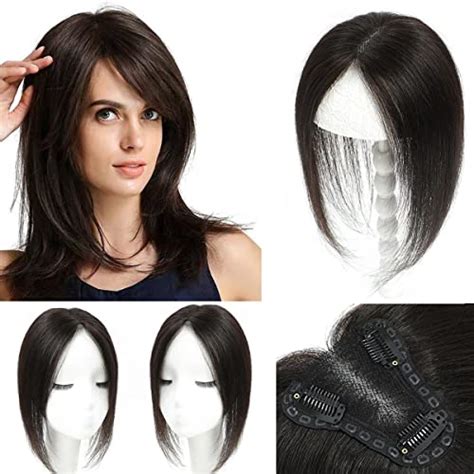If you’re experiencing hair loss or thinning, a hair topper can be an excellent solution to regain fullness and confidence in your appearance. With advancements in technology, hair toppers are now more natural-looking and comfortable to wear than ever before. However, finding the right topper for your individual needs can be overwhelming, especially with the vast array of options available.

In this comprehensive guide, we’ll explore the different types of hair toppers, their benefits, and guide you through the process of choosing the perfect one for your hair concerns. We’ll also provide tips and tricks to ensure a secure, comfortable, and natural-looking fit.
Types of Hair Toppers
1. Clip-In Hair Toppers
Clip-in toppers are the most common type of toppers, allowing for easy and quick application. They feature a base with attached hair fibers that are secured to your existing hair with clips. Clip-in toppers offer versatility and convenience, as they can be removed at night or when not needed.
2. Tape-In Hair Toppers
Tape-in toppers use a thin, double-sided tape to adhere to your own hair. This method provides a longer-lasting hold compared to clips, typically lasting for 4-6 weeks. Tape-in toppers are less visible than clip-in toppers and are suitable for women with coarser hair.
3. Fusion Hair Toppers
Fusion toppers are attached to your hair using heat-activated bonding agents. This method is permanent and requires professional installation at a salon. Fusion toppers offer excellent durability and longevity, lasting up to 6 months with proper maintenance.
Benefits of Hair Toppers
1. Conceal Hair Loss
Hair toppers effectively conceal hair loss, thinning areas, or receding hairlines. They provide instant volume and coverage, giving you the appearance of fuller, healthier hair.
2. Enhance Appearance
Toppers can enhance your overall appearance by adding volume, length, and movement to your hair. They can frame your face, create a more balanced silhouette, and boost your confidence.
3. Experiment with Styles
Toppers allow you to experiment with different hairstyles without damaging your own hair. You can try new lengths, colors, and textures without the commitment or potential damage associated with chemical treatments or styling tools.
How to Choose the Right Hair Topper
1. Hair Thickness and Texture
Consider the thickness and texture of your existing hair when selecting a topper. Choose a topper that matches your hair’s density and texture for a natural-looking blend.
2. Color and Length
Match the color and length of the topper to your own hair for a seamless transition. If you’re unsure about the right color, consult with a professional stylist.
3. Base Size and Shape
Select a topper base size that covers the areas of hair loss or thinning. The shape should complement your head shape and provide a secure fit.
4. Attachment Method
Choose an attachment method that suits your lifestyle and hair type. Clip-in toppers are easy to use but may not be as secure as tape-in or fusion toppers.
Tips and Tricks for Hair Topper Success
1. Blend Your Hair
To achieve a natural blend, tease your hair slightly at the base where the topper will be attached. This will create a soft transition between your hair and the topper.
2. Avoid Over-Styling
Styling tools can damage the fibers on your topper. Use heat protectant sprays and avoid excessive heat styling to maintain the topper’s longevity.
3. Wash Regularly
Wash your topper regularly using a gentle shampoo and conditioner. Avoid harsh chemicals and excessive water pressure to preserve the hair fibers.
Common Mistakes to Avoid
1. Choosing the Wrong Size
Selecting a topper that is too large or too small can result in an unnatural fit or discomfort. Consult with a professional to determine the correct size for your head.
2. Improper Attachment
Improperly attaching the topper can lead to slippage or damage to your own hair. Follow the manufacturer’s instructions carefully and use professional assistance if necessary.
3. Over-Styling
Excessive brushing or styling can tangle or damage the hair fibers on your topper. Handle it gently and use styling products that are specifically designed for hair toppers.
Choosing the Best Hair Topper for Your Hair Concerns
To assist you in making an informed decision, we’ve compiled a table that outlines the different hair concerns and the most suitable topper types for each:
| Hair Concern | Suitable Topper Type |
|---|---|
| Thinning hair | Clip-in or Tape-in toppers |
| Balding spots | Fusion toppers |
| Receding hairline | Tape-in or Clip-in toppers |
| Diffused hair loss | Fusion or Tape-in toppers |
Table 1: Hair Concerns and Topper Types
In addition to the hair concerns listed above, toppers can also be used for:
- Fashion statement: Experiment with different colors, lengths, and textures to create unique and stylish looks.
- Thickening fine hair: Add volume and fullness to fine or thinning hair without the weight of extensions.
- Protecting damaged hair: Toppers can help protect damaged hair from further chemical or heat-related damage.
Conclusion
Hair toppers offer an effective and versatile solution for women experiencing hair loss or thinning. By choosing the right topper for your individual needs and following proper care instructions, you can achieve a natural-looking and confident appearance. Remember, the best hair topper is the one that seamlessly blends with your hair, enhancing your beauty and boosting your self-esteem.
